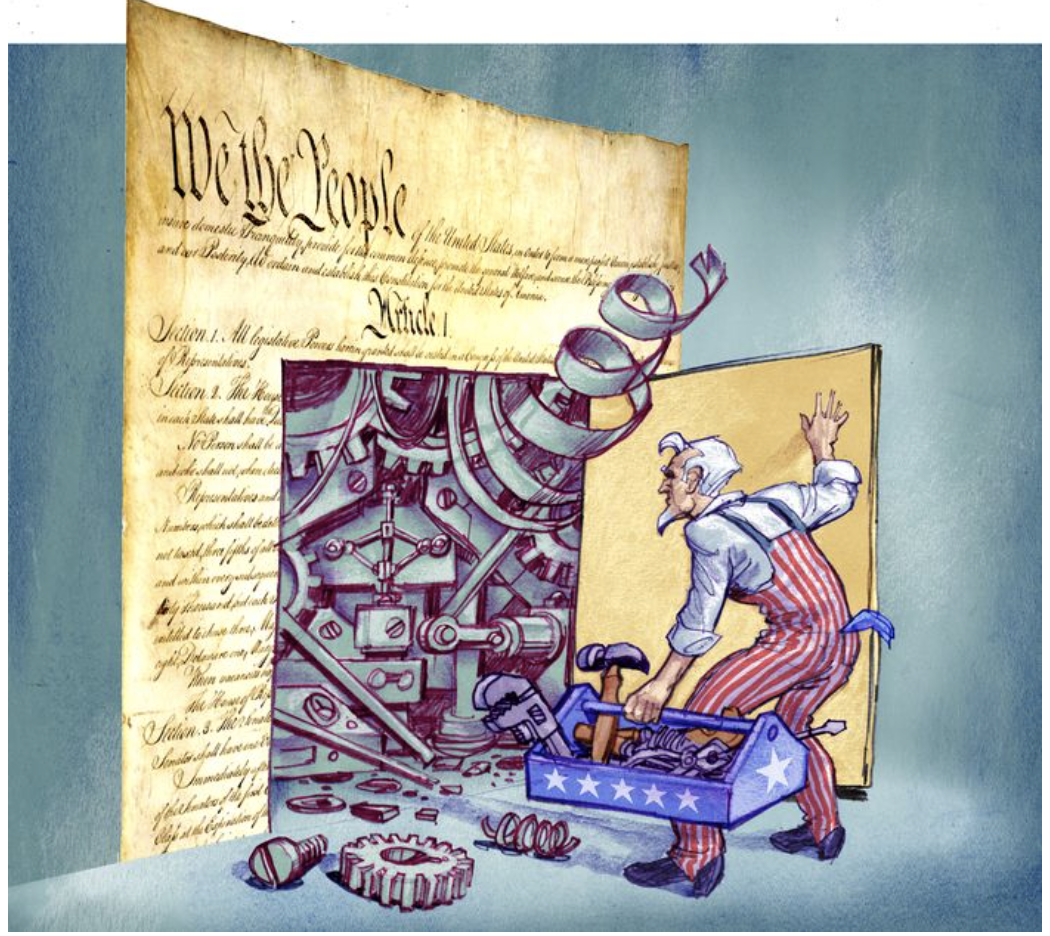By: May 9, 2023
The separation of powers is an animating principle of our nation’s founding documents. As the Constitution outlines, the U.S. has three distinct and coequal branches of government: a legislature that passes laws, an executive branch that implements them, and a judiciary that interprets them. This built-in division is meant to restrain government overreach and prevent abuses of power. The president and members of Congress regularly stand for election to ensure the government is accountable to the governed, and the judiciary serves in good behavior to ensure that justice is dispensed impartially.
While this sounds nice in theory, the federal government typically doesn’t honor it in practice. Congress has delegated much of its lawmaking authority to the executive branch since the 1930s. Federal agencies now issue regulations that have the force and effect of the law. “Administrative judges”—executive-branch employees—routinely preside over trial-like proceedings without juries, letting agencies act as both prosecutor and judge.
Under the Supreme Court’s Chevron doctrine, courts generally defer to the executive branch’s interpretation of the law—both in regulatory and enforcement proceedings. Many of the Constitution’s checks and balances, from the separation of powers to the right to jury trial, have fallen by the wayside.
So has much of the government’s democratic accountability. The federal government has 2.2 million civilian employees, but only 4,000 of them are political appointees the president can remove at will. Career bureaucrats, who aren’t elected by the American people or appointed by the president, therefore make many major policy decisions. Civil-service protections make removing these employees incredibly difficult—and they know it.
The system presumes career employees will implement the law and presidential directives irrespective of their personal preferences. To their credit, many do. During my time in the Interior Department, I saw many career employees faithfully work for the American people.
Unfortunately a great number of their colleagues don’t. I vividly recall asking one Interior Department employee, whose remit included work on an endangered mouse species, what her job was. She enthusiastically replied: “I speak for the mice! I speak for the mice!” She was well-meaning, but “speaking for the mice” wasn’t in her job description. Her job was to apply the provisions of the Endangered Species Act faithfully—both the protections and limitations Congress wrote into the statute. She instead appeared to be an advocate fighting for a cause.
Many career bureaucrats take this view. During my 12 years in government I often saw career bureaucrats push their preferred policy passions irrespective of agencies’ rules, federal regulations or the law. This included career employees needlessly limiting recreational activities in national parks, imposing unneeded burdens on historic preservation and inappropriately restricting activities in the name of species preservation. The list goes on, as does our nation’s departure from representative democracy.
Such behavior is especially troubling when the bureaucracy is out of step with America. While recent elections show the American people are closely divided politically, the federal workforce isn’t. Democrats outnumber Republicans by nearly 2 to 1 among career federal employees, creating an imbalance that makes it very difficult to advance policies that partisan bureaucrats oppose.
America saw how our partisan bureaucracy works when the New York Post reported on Hunter Biden’s laptop in October 2020. Though the story credibly documented that the Biden family had benefited from profitable influence peddling with foreign interests, 51 former intelligence officials publicly claimed the laptop had “all the classic earmarks of a Russian information operation.” The media, along with tech platforms like Facebook and Twitter, then used the letter to justify burying the story.
And buried it was, never mind that the laptop’s contents were genuine, as Hunter has admitted. To make matters worse, the House Judiciary and Intelligence committees have since uncovered that Joe Biden’s presidential campaign helped organize the letter. In other words, a group of primarily career intelligence officials that ought to be disinterested in political matters endorsed a partisan ruse to affect a presidential election.
Fortunately, there are signs of hope. A president with sufficient political will can make the bureaucracy accountable under current laws. In 2020 President Trump issued the Schedule F executive order converting senior policy-influencing career bureaucrats into at-will employees. While the order would apply only to a small portion of the total federal workforce, it would cover the most powerful career bureaucrats. Mr. Biden rescinded this order two days after taking office, but a future president could bring it back.
The high court also announced last month that it will hear arguments next term in Loper Bright Enterprises v. Raimondo—a case that will reconsider Chevrondeference. If the justices overturn the precedent, or at least significantly pare it back, executive agencies will no longer get to administer and interpret the law. Such a ruling would go a long way in restoring essential constitutional checks and balances.
The Supreme Court has also made it easier to sue over separation-of-powers violations. In Axon v. FTC, which the court decided last month, all nine justices agreed that Americans can immediately sue agencies over separation-of-powers violations without first having to spend years spinning their wheels in administrative proceedings. In a concurrence, Justice Clarence Thomas added that the court should re-examine whether agencies can constitutionally impose fines without a jury trial. A case addressing that very issue, SEC v. Jarkesy, may come before the high court next year.
The government doesn’t operate the way Americans are taught in elementary school. But between pending court cases and potential executive-led reforms, the theoretical checks and balances and democratic accountability may soon become much closer to reality.
To see this article in its entirety and subscribe to others like it, please choose to read more.
 Listen Online
Listen Online Watch Online
Watch Online Find a Station in Your Area
Find a Station in Your Area









 Listen Now
Listen Now Watch Online
Watch Online
